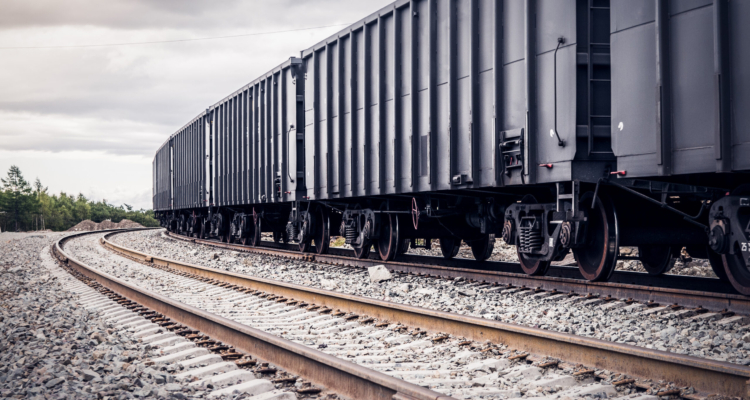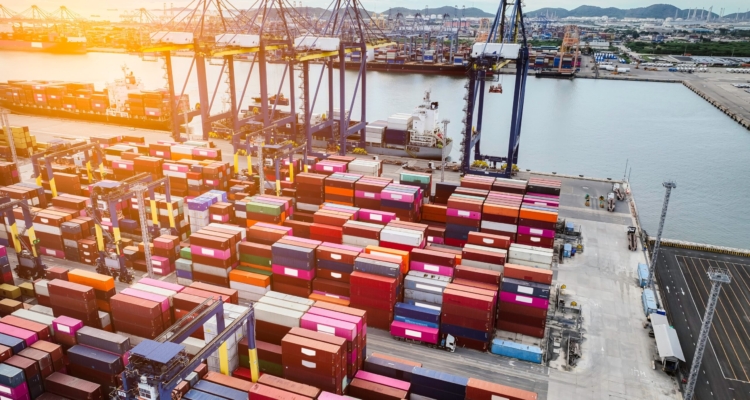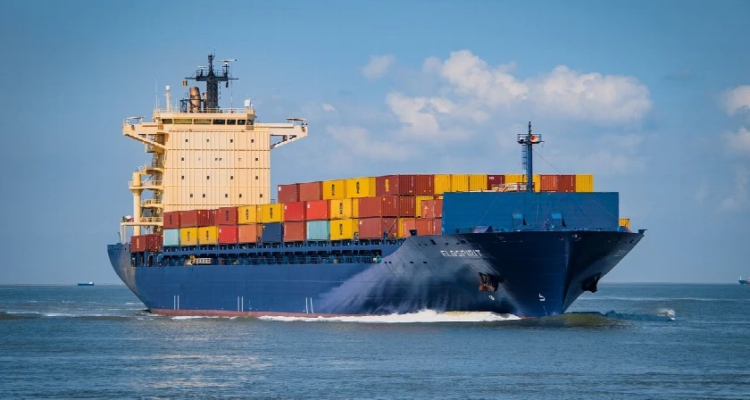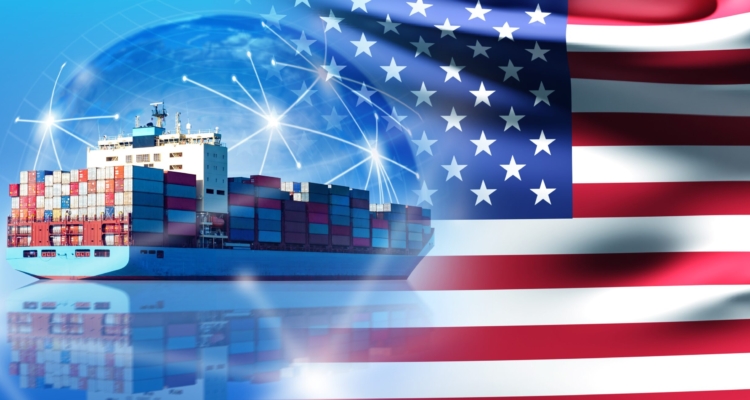U.S. economy grows 2.7% amid global slowdown
A recent report from Bloomberg showed that the U.S. economy is showing strong growth as 2024 comes to an end, and experts expect the government's preliminary estimate of fourth-quarter gross domestic product (GDP) to show a substantial annualized growth of 2.7%. Also Read: Dollar Hits All-Time Highs Amid Fed Signal This booming growth has been driven largely by healthy consumer spending, fueled by a strong labor market, and a significant gap between the U.S. and other global economies. U.S. personal consumption of goods and services is expected to maintain an annualized growth rate of more than 3% for the second consecutive quarter. In sharp contrast, the European economy has fallen into a downturn. Recent forecasts suggest that the French economy will stagnate by the end of 2024, Germany will contract slightly, and overall euro zone growth will continue a multi-year trend of modest expansion. Specifically, the Eurozone's fourth-quarter GDP growth is expected to be only 0.1%, further highlighting the gap…
E-commerce boom insulates air cargo from volatility
The air cargo industry is facing continued volatility as changing global conditions threaten to dampen demand. Although air cargo volumes surged 18% last year, Scan Global Logistics (SGL) warned that double-digit growth may not be achieved in 2025. Also read: Air cargo growth to slow in 2025 SGL attributed last year's strong performance to shipping disruptions caused by the Red Sea crisis. However, recent progress in addressing attacks in the region may reduce reliance on air cargo, potentially affecting near-term demand. David Jinks, head of consumer research at Parcelhero UK, highlighted further challenges, including possible policy shifts under the new US administration. "Traders driving growth in US online sales may face increased scrutiny from the IRS, while Trump-era tariffs could redirect UK manufacturers towards the EU," Jinks explained. Meanwhile, a report from Danish shipping giant Maersk highlighted the growing trend of localization and regional supply chains. Factors such as the need for faster delivery, lower costs and mitigating geopolitical risks…
U.S. national debt will increase by $23.9 trillion
The U.S. Congressional Budget Office (CBO) predicts that the U.S. national debt will increase by $23.9 trillion over the next 10 years. This forecast on Yahoo Finance ignores the impact of President-elect Donald Trump's proposed tax cuts, which could add trillions of dollars. Also read: Economic impact of US TikTok ban While increases in taxable revenue have provided some relief, the Congressional Budget Office's latest 10-year budget outlook paints a challenging fiscal picture. The annual budget deficit is expected to reach 6.1% of U.S. GDP by 2035, significantly higher than the 50-year average of 3.8%. The Trump administration, which aims to extend the 2017 tax cuts, faces a potential deficit of more than $4 trillion without significant spending cuts. New Treasury Secretary candidate Scott Bessant has warned that failure to implement tax cuts could lead to a recession. The Congressional Budget Office's forecast deficit is slightly lower than previous estimates, primarily due to an expected increase in taxable revenue. However,…
The intermodal transport market will experience strong growth in early 2025
The intermodal market continues to maintain impressive peaks in the first few months of 2025, as observed in the third week of January, with a significant surge in volumes that breaks typical seasonal trends. According to Yahoo Finance, year-over-year growth surged to 27%, driven significantly by high export rates from China, strong U.S. consumer demand and a buildup of inventories ahead of potential tariffs. Also Read: Trucking and Intermodal Industry: Addressing Demand and Capacity Challenges IndexBox data further supports these findings, reporting that rail intermodal volumes are growing at an unprecedented rate, with CPKC, Union Pacific and Canadian National leading the expansion. CPKC's intermodal volume increased 38%, followed by Union Pacific and Canadian Airlines, which increased 36% and 31% respectively compared with the same period last year. Elsewhere, BNSF gained 29%, CSX gained 28% and Norfolk Southern gained 20%. Sea container volumes bound for the United States also recovered strongly in January 2025, hinting at a broader, sustained recovery pattern.…
Canadian provinces brace for rising U.S. borrowing costs
Canadian provinces are bracing for rising borrowing costs as looming U.S. tariffs threaten to curb economic growth. Bloomberg reported that shrinking trade could lead to lower provincial tax revenues, potentially higher borrowing needs and lead to higher provincial debt risk premiums. Also read: U.S. companies hoard Chinese goods amid tariff uncertainty Dominic Lapointe, director of macro strategy at Manulife Investment Management, said the impact of potential tariffs is not yet reflected in provincial debt spreads but could soon exacerbate financial challenges. Analysts including Canadian Imperial Bank of Commerce expect that even a 20 per cent tariff could widen provincial spreads on the 10-year Treasury note by as much as 12 basis points. With provinces expected to borrow about $135 billion in fiscal 2025, the additional borrowing costs could translate into about $162 million in additional interest per year. Ontario, Canada's largest province, recently sold C$750 million in bonds, a 60 basis point spread over the government's benchmark. This highlights investor…
Container Exchange Customer Inquiry: Trump 2.0, Tariffs
Donald Trump's inauguration as the 47th President of the United States on January 20, 2025, marked the beginning of a new chapter in global trade. Also read: Trump's proposed tariffs could trigger price increases and supply chain disruptions "With renewed emphasis on the 'America First' agenda, the Trump administration is preparing to make structural changes to global trade relationships. These changes are expected to impact key trade routes, tariffs, agreements and supply chain dynamics, prompting businesses across industries to adapt quickly Changing Logistics Costs and Productivity” shared. Christian Roeloffs, co-founder and CEO of Container xChange. “Higher tariffs, stricter trade agreements and the potential reorganization of key trade routes – especially amid geopolitical tensions such as the Panama Canal dispute – will challenge global supply chains and force container traders and shipping lines to adapt. " "At the same time, these shifts may create Opportunities for regional trade growth, alternative trade corridors, Strengthen cooperation among emerging markets. While the removal of…
Samsung and LG consider moving production to U.S.
South Korean electronics giants Samsung and LG are considering strategically moving some of their home appliance manufacturing operations from Mexico to the United States. According to Reuters, there were recent reports that both companies are seeking to mitigate the potential impact of a possible 25% tariff on imports from Canada and Mexico, as U.S. President Donald Trump considers it. Samsung Electronics is evaluating moving its dryer production from Mexico to a plant in South Carolina. Meanwhile, LG Electronics is evaluating a similar move at its refrigerator manufacturing, possibly relocating it to a factory in Tennessee that already makes washers and dryers. This strategic move is underlined by IndexBox data, which highlights changes in global manufacturing and trade patterns, underscoring the importance of production system agility and adaptability to geopolitical factors. Both companies said they would continue to respond to market changes, with Samsung saying it planned to closely monitor developments and adjust its international operations accordingly. Likewise, LG Electronics aims…
Descartes Study: 74% of Supply Chain Leaders Focus on Technology
Global trade intelligence and global trade analytics are top technologies expected to deliver business value Descartes Systems Group, a global leader in allied logistics-intensive business enterprises, has released findings from its research report, What Companies Are Doing to Address Escalating Global Supply Chain Challenges. Research shows that in the face of growing global trade challenges such as tariffs and trade barriers, supply chain disruptions and geopolitical instability, 74% of supply chain and logistics leaders surveyed view technology as critical or very important to their organization’s growth strategy important. That number jumps to 88% for companies expected to grow more than 15% over the next two years. Additionally, 59% of respondents believe technology is extremely or very important in providing a competitive advantage in international trade. Also read: Addressing global trade risks through strategic financial planning When considering which technology capabilities are expected to help companies involved in international trade grow their business and gain a competitive advantage, 36% of respondents…
U.S. Interest in Greenland – The Case for Shipping and Reserves
The media is in tears over President Trump’s interest in acquiring Greenland. Few would argue that the president's rhetoric has always been measured. Part of his appeal lies in his off-the-cuff remarks, which in turn create news and spark debate. As a marketer, the president is probably one of the best marketers of all time. Staying relevant is the point. Also read: Global shipping markets face turmoil as tanker rates soar on China routes Yet behind the 15-second Greenland quip lay the strategic dimension of Trump's desire for an Arctic behemoth. More than three times the size of Texas, Greenland is attractive due to its proximity to emerging shipping routes, vast undiscovered oil and gas reserves and rare earth deposits. China's growing advances and Russia's proximity have unsettled the president, and a more established U.S. presence in Greenland, or an outright acquisition of the territory, appears to be on the incoming administration's table. shipping box As the Earth warms, melting…
Blockchain explained: Why it’s more than just Bitcoin
Blockchain technology is quickly gaining traction as an advanced system that was originally the inspiration for Bitcoin and now impacts many industries. While many people only associate blockchain with cryptocurrencies, its capabilities extend far beyond virtual currencies. In this newsletter, we’ll dive into the basics of blockchain, highlight its many applications, and explain why it’s more than just Bitcoin. We will also discover how concepts such as Bitcoin wallets function within the wider blockchain environment. Also read: Competitive advantage: Leveraging AI, blockchain and analytics to improve supply chain management What is blockchain Blockchain is a decentralized virtual ledger that counts information in a stable, obvious, and tamper-proof manner. Its key properties include: Decentralization: There is no valuable authority that controls the blockchain; it is maintained through a community of computers (nodes). transparency: All transactions are visible to individuals, increasing trust. Immutability: Once a transaction is recorded, it cannot be changed or deleted. Every piece of data on the blockchain is…
U.S. companies will earn more than European companies
U.S. companies will outperform their European peers in the upcoming earnings season JPMorgan strategists predict that U.S. companies will significantly outpace their European peers in profit growth this earnings season. For detailed insights, you can visit the original source here. Lower expectations for S&P 500 companies played a crucial role as analysts slashed their forecasts despite strong U.S. economic growth. Also read: Economic impact of US TikTok ban European expectations bring challenges In contrast, European companies face "much stronger" expectations, strategist Mislav Matejka said. This situation could cause difficulties for European companies, especially given the differences in the momentum of activity across regions. The situation creates additional risks for European stocks, especially after one of the most challenging years for the region's stock market performance relative to the United States. There are differences in performance indicators Last year, the Stoxx 600 lagged the S&P 500 by more than 17 percentage points, its second-worst relative performance since 1998. Factors such as…
Trump’s Panama Canal ultimatum sparks global controversy
Trump revisits canal dispute in inauguration speech In his inauguration speech, U.S. President Trump vowed to "take back" the Panama Canal, once again triggering controversy in U.S.-Panama relations. Trump has accused Panama of violating a 1999 treaty that completed the handover of the canal and accused China of mismanagement and undue influence, claims Panama vehemently denies. Also read: Panama Canal faces key decisions amid climate-induced drought "We didn't give it to China. We gave it to Panama and we're going to take it back," Trump declared, without specifying a timeline or method for the proposed takeover. Panama firmly refutes Panamanian President José Raul Mulino responded on X (formerly Twitter) that the canal was being managed responsibly to facilitate global trade, including for U.S. interests. “The Panama Canal is and will remain Panama’s canal,” Mulino asserted, stressing the country’s sovereignty. Controversial Destiny Revival Trump’s speech also evoked the 19th-century concept of “Manifest Destiny” and hinted at U.S. territorial expansion ambitions. He…
Global shipping market faces turmoil in tanker rates
According to Bloomberg, the cost of chartering supertankers on key routes to China has increased sharply in light of recent U.S. sanctions on Russia. The development highlights the broader impact of geopolitical tensions on global shipping markets. Also read: Global shipping faces turmoil: Chokepoint disruption threatens trade and supply chains Daily rates for very large crude carriers (VLCCs) on the Middle East to China route surged 112% to $57,589 after sanctions were imposed on about 160 tankers transporting Russian crude, according to Baltic Exchange data. Similarly, the US Gulf to China and West Africa to China routes also increased by 102% and 90% respectively. At the same time, Chinese refineries are urgently purchasing crude oil from the Middle East, Africa and the Americas to make up for the shortage of Russian oil. A VLCC shipped from the US Gulf to China was booked last week at US$9.5 million, significantly higher than the low of US$7 million in previous months. In…
U.S. invests $1 billion in domestic lithium supply
The United States approved a nearly $1 billion loan to Australian mining company Ioneer to build its lithium processing plant in Nevada to ensure the security of its domestic lithium supply chain. Mining.com details the key move, which is part of outgoing President Joe Biden's strategy to reduce U.S. reliance on China, the market leader in lithium production and exports. The loan will facilitate construction of a plant planned to produce 22,000 tons of lithium per year by 2028, strategically supplying auto giants such as Ford and other electric vehicle (EV) manufacturers. The DOE loan and ongoing mitigation efforts are designed to address such global changes and secure lithium resources as part of a broader agenda to promote a sustainable and independent electric vehicle industry in the United States. Source: IndexBox Market Intelligence Platform
Rail to prosperity: rail freight market poised for growth
In the modern logistics era, the rail freight industry is becoming the cornerstone of global trade, and its market valuation is expected to reach a staggering US$522.4 billion by 2032. With its inherent advantages of cost-effectiveness, sustainability and reliability, rail freight is on a path to unprecedented growth. This article delves into the driving forces behind this emerging market, its challenges and future opportunities. Also read: U.S. rail industry faces uncertain future amid economic and policy challenges Current status of railway freight Rail freight has long been a mainstay of the industrial economy, providing a reliable means of transporting goods over long distances. It is particularly favored by bulk commodities such as coal, minerals and agricultural products, but recent trends point to its growing role in intermodal transport, where goods are transported in containers that can move seamlessly between trucks, ships and trains move. 2022, global rail freight market The industry is already a robust one, benefiting from increasing globalization…
U.S. companies hoard Chinese goods amid tariffs
Expectations that President-elect Donald Trump may impose new tariffs have fueled a surge in U.S. imports from China, as companies rush to buy goods before potential trade restrictions take effect. Also read: World Bank warns of global economic impact of proposed US tariffs Imports surge ahead of policy shift In December, U.S. seaports handled the equivalent of 451,000 40-foot containers of cargo from China, a 14.5% increase year-over-year, according to Descartes Systems Group. Compared with 2023, U.S. imports of products such as bedding, toys and electronics increased by 15%. The increase reflects concerns about impending tariffs on manufactured goods, with Trump having proposed tariffs of 10% to 60%. Unlike his first term, when tariffs focused on parts and components, experts predict the next wave of tariffs may focus on consumer goods. "China's final product exports to the United States have increased as importers aim to preempt potential tariffs on consumer goods," said Frederic Neumann, chief Asia economist at HSBC. Corporate…
The economic impact of the U.S. ban on TikTok
The impending U.S. ban on TikTok could cost the U.S. economy billions of dollars and disrupt a vital platform for millions of U.S. businesses and social media entrepreneurs. According to a report from Yahoo Finance, the app's disappearance won't have a major impact on the overall U.S. economy, but could hurt the booming sub-economy built around it. Also read: China considers selling TikTok's US operations to Elon Musk Data from the IndexBox platform shows that TikTok has approximately 170 million U.S. users, its influence spans various industries, and will contribute more than $24 billion to the U.S. economy by 2023. Although TikTok reportedly generates more than $20 billion in annual revenue, this figure remains difficult to verify. The app's impact is evident in individual cases, such as Ella Livingston's Cocoa Asante in Chattanooga, Tenn., which risks losing $25,000 in monthly sales and potentially forcing part-time workers to be laid off. In addition, TikTok's digital store's gross merchandise value in the…
Despite Gaza, Red Sea trade routes face long-term uncertainty
Even after a ceasefire between Israel and Hamas, global shipping companies remain hesitant to return to Red Sea trade routes as ongoing security concerns over attacks by Houthi rebels in Yemen remain. Also read: Houthi Red Sea attack disrupts global shipping, Interior chief urges action Ongoing threats undermine confidence The leader of Yemen's Houthi rebels recently announced that the group would monitor the ceasefire and could resume attacks on shipping if the ceasefire was breached. Since November 2023, the Houthis have carried out more than 100 attacks on ships in solidarity with the Palestinians in Gaza, sinking two ships, seizing another, and killing at least four sailors. The wave of attacks has caused significant disruption to global shipping and led many companies to reroute ships around the Cape of Good Hope, bypassing the Red Sea and Suez Canal entirely. Industry leaders choose safer route Executives in industries including shipping, insurance and retail stressed that risks in the Red Sea remain…
World Bank warns of proposed global economic impact
The World Bank has issued a warning report on the impact of proposed U.S. tariffs, suggesting global economic growth could be hampered if countries retaliate with tariffs of their own. According to Reuters, the imposition of a comprehensive 10% tariff may further reduce global economic growth in 2025 by 0.3 percentage points from the expected 2.7%. In addition, potential retaliation could reduce the U.S. economic growth forecast for 2025 by 0.9%, or 2.3%. Also read: World Bank warns it could take more than a century to end poverty in half the world The World Bank's Global Economic Prospects report highlights that the global economic outlook is essentially stagnant, with growth rates of 2.7% in 2025 and 2026, the same as in 2024. Additionally, IndexBox data shows a significant increase in global trade restrictions, now five times greater between 2010 and 2019. Combined with the fact that foreign direct investment in developing economies has halved since the early 2000s, it paints…
As the global economy rises, developing economies face sluggish growth
Long-term growth prospects weaken for first time this century The latest World Bank report shows that developing economies, which contribute 60% to global growth, are facing the weakest long-term growth forecast since 2000. global economic outlook Report. Although the global economy is expected to stabilize, with growth expected to be 2.7% in 2025 and 2026, developing countries are still making slow progress in narrowing the income gap with advanced economies. Also read: World Bank warns it could take more than a century to end poverty in half the world In the next two years, developing economies are expected to maintain growth of around 4%. However, this pace is below pre-pandemic levels and insufficient to alleviate poverty or achieve broader development goals. Main findings The report provides a comprehensive review of the performance of developing economies in the first quarter of the 21st century. It highlights three important trends: 1. Decline in growth rate: Growth in these economies fell from 5.9%…
How artificial intelligence is revolutionizing maritime safety management
The maritime industry is embracing digital transformation, with the emergence of artificial intelligence (AI) becoming a game-changer for safety management. Companies like WiseStella are leveraging AI to streamline compliance, reduce cognitive stress on seafarers, and improve safety standards across global fleets. Using AI to solve the problem of document overload Today, seafarers face complex safety regulations and increasing documentation requirements. Ali Demiral, chief technology officer at WiseStella, said this "cognitive load" can create stress, especially during security assessments. To address this challenge, WiseStella developed an artificial intelligence solution called “Wise-AI” that uses large language models (LLMs) to analyze historical safety data and provide actionable insights. “Wise-AI enables mariners and managers to respond to new safety requirements with confidence,” explains Demiral. For example, if a crew member is unsure about compliance during a self-assessment, Wise-AI can analyze the input details and suggest potential problem areas with tailored recommendations. This proactive approach not only saves time but also increases seafarers’ understanding of…
Eaton fire poses credit risk to Southern California Edison
Eaton fire threatens Southern California Edison's credit rating The Eaton Fire has destroyed more than 14,000 acres in central Los Angeles County since Jan. 7, raising serious credit risk concerns for Southern California Edison (SCE), the region's main power supplier. SCE's financial stability could be affected by the location of its operations near where destructive fires originate, according to a report from Moody's Ratings. Potential Liability and the Role of SCE Although multiple lawsuits have been filed against SCE, investigations are ongoing and an official cause of the fire has not yet been determined. The plaintiffs claim the initial flames may have been caused by the utility company's equipment. SCE, a subsidiary of Edison International, insists there is currently no evidence linking its infrastructure to the fire. Financial impact and market reaction Moody's outlined that the state wildfire fund and the mechanism by which California utilities recover fire-related expenses currently support SCE's credit profile. However, this could be undermined if…
As China market slows, luxury brands shift focus to U.S.
Luxury brands look to the U.S. as China market weakens Global luxury goods companies are gearing up to woo U.S. consumers with lavish diamond jewelry and exquisite leather handbags amid forecasts of a softening market in China. Retail executives aim to capitalize on wealth generated by a strong performance in U.S. stocks and rising cryptocurrencies, according to a report from Yahoo Finance. Tariffs proposed by U.S. President-elect Donald Trump are also expected to boost the dollar and increase Americans' purchasing power for European luxury goods. The strategic shift comes as the 363 billion euro ($373.16 billion) global luxury goods market faces its slowest sales in recent years. China's economic downturn and real estate crisis have dampened demand for luxury goods, while rising living costs in Europe have curbed luxury spending. The industry has endured stock market turmoil after the post-pandemic spending spree fell, but is now bracing for potential weakness, with LVMH's market capitalization losing more than 30 billion euros…
Seamless Inspection: Breakthrough Innovation
Member Companies: Dubai Customs’ seamless inspection program has reduced processing times by 50%. Improve operational efficiency and accelerate supply chain processes. Abdulla Busenad: “Dubai Customs provides groundbreaking customs services that support the business sector and enhance Dubai’s trade and logistics competitiveness.” Members of the ‘Seamless Inspection’ initiative launched by Dubai Customs are very satisfied with the positive and effective impact of this ground-breaking initiative in improving supply chain management efficiency, accelerating logistics operations, improving operational efficiency and reducing customs inspection time. They stressed that Dubai Customs' unique and world-leading customs services significantly contribute to improving company performance indicators, increasing customer satisfaction and attracting new foreign investments in the commercial, logistics and related industries. His Excellency Dr. Abdulla Busenad, Director General of Dubai Customs, expressed this view during a visit to the Aramex warehouse with his accompanying delegation. The visit marked the official launch of the service and provided an on-site inspection of the customs inspection process at the company's location.…
U.S. and Norway unite to increase transparency
The U.S. Department of Commerce and the Norwegian Ministry of Trade, Industry and Fisheries have jointly released an innovative report analyzing how non-market policies and practices (NMPP) impact global critical minerals markets. The study, known as the NMPP Report, highlights the challenges posed by practices in some third countries that distort markets for minerals necessary for sustainable technologies. Also Read: Commerce Department Expands Advocacy Efforts to Boost U.S. Global Competitiveness The report, led by the International Trade Administration's Industry and Analysts team, marks an important step forward in the United States and Norway's shared goal of promoting sustainable, market-driven mining and processing activities. “Securing critical minerals supply chains is critical to national security and economic competitiveness,” said Grant Harris, Assistant Secretary of Commerce for Industry and Analysis. “This report provides a detailed assessment of how the NMPP is disrupting these important markets, guiding market-oriented economies and industry partners to strengthen supply chain resilience.” The NMPP report explores the mineral supply…
Trucking and Intermodal Industry: Guiding Demand and
The trucking industry has seen a complex interplay between demand and capacity dynamics in recent months. A recent FreightWaves article noted that declining truckload demand masks freight capacity exiting the market, in part due to seasonality. Although the National Outbound Bid Volume Index (OTVI), SONAR's primary measure of bid volume, fell 2% year-on-year, bid rejection rates and spot rates increased, indicating a capacity-driven tightening trend. Analysts expect these rates could rise further as demand strengthens during the traditionally busy months starting in March. Also read: Cargo volumes plummet in December, trigger rates rise At the same time, the intermodal industry experienced one of its strongest years on record. Data from the Association of American Railroads confirms that 2024 is the third strongest year in history for intermodal traffic, with December 2024 recording the highest December intermodal traffic on record. This growth was primarily driven by strong consumer spending and import activity, as shippers utilized intermodal solutions despite challenges with rail…
Commerce and MACOM partner to support U.S.
The U.S. Department of Commerce has signed a Preliminary Memorandum of Terms (PMT) with MACOM Technology Solutions Inc. proposing up to $70 million in direct funding under the CHIPS and Science Act. This investment is designed to increase the resiliency of the U.S. defense and telecommunications supply chain by expanding and modernizing MACOM's facilities in Lowell, Massachusetts, and Durham, North Carolina. Also Read: Commerce Department Expands Advocacy Efforts to Boost U.S. Global Competitiveness The move is expected to create up to 350 new manufacturing jobs and nearly 60 construction jobs in the two states. "This announcement demonstrates how CHIPS for America is making strategic investments to strengthen supply chain security and advance U.S. technology leadership," said U.S. Commerce Secretary Gina Raimondo. Designated by the Department of Defense (DoD) as a Category 1A Trusted Foundry, MACOM's facilities play a critical role in the production of advanced compound semiconductors. These components support high-frequency defense systems such as radar and are critical for…
Freight volume plummets in December, trigger rate
Cass Information Systems highlighted that the latest data showed a significant decline in freight volumes in December. The report noted that while expenditures were less affected, it indicated an increase in shipping costs during the month. This is consistent with data from the IndexBox platform, which tracks freight market trends. Also read: Post-Christmas rejection surge in U.S. truckload market According to the Cass Freight Index, freight volume fell 7.3% from November and 6.5% year-on-year. The figures reflect the largest annual decline since January 2024 and the lowest index reading since June 2020. Notably, the index primarily covers trucking, with most freight modes experiencing downturns, including less-than-truckload, rail and parcel shipments. Seasonal trends and holidays are factors, as are shippers speeding up deliveries to forestall a possible dockworker strike. The freight expenditure index, which reflects total freight expenditure including fuel costs, fell 2.6% month-on-month but rose 0.5% on a seasonally adjusted basis. The economic downturn in December this year was associated…
Microsoft poised to benefit from surge in AI spending
As Microsoft shares edged lower in early trading on Tuesday, Morgan Stanley analysts positioned the tech giant as a potential beneficiary of an expected surge in artificial intelligence-related spending in 2025. According to a report from Yahoo Finance, Microsoft will use an $80 billion investment aimed at expanding its artificial intelligence-centric strategy and enhancing its data centers. This massive investment is designed to support their existing model and introduce cloud-based solutions to a broad customer base, with more than half of spend specifically in the US. Data provided by the IndexBox platform shows that Microsoft’s move comes at a time when global artificial intelligence investment trends are changing. A recent survey highlighted that software spending is expected to grow by 3.8% by 2025, with enterprises increasingly favoring Microsoft's Azure as their preferred provider. Currently, Azure manages about 54% of the overall workload, highlighting Microsoft's leadership in cloud services. Microsoft's strategic move is consistent with findings from International Data Corporation, which…
China considers selling TikTok U.S. operations to Elon
Chinese authorities are reportedly considering selling TikTok's U.S. operations to Elon Musk, a major development. For more details, the original report can be accessed here. According to Bloomberg, the move is a strategic response if the popular social media app faces a potential ban in the United States. The expected deal could significantly reshape the competitive dynamics of the social media landscape. Data from the IndexBox platform, which reaches millions of users every day, underscores the growing economic impact of TikTok in the United States. Speculation about a sale to a high-profile entrepreneur like Elon Musk underscores the platform's global importance and ongoing geopolitical tensions affecting technology companies. Source: IndexBox Market Intelligence Platform
U.S. rail industry faces uncertain future amid economic climate
The U.S. railroad industry faces a future filled with great uncertainty while grappling with numerous economic and policy challenges, according to the Association of American Railroads' (AAR) latest annual railroad industry outlook. This comprehensive report highlights the impact of likely changes to fiscal policy, trade, immigration, taxation and regulatory frameworks heading into 2025. Also read: U.S. container imports strong in December 2024, but potential challenges loom in 2025 Despite widespread uncertainty, the rail industry ended 2024 strong, with intermodal volumes reaching its third-highest annual figure. Data from the IndexBox platform shows that although coal shipments continue to decline, consumer spending supported by a strong labor market has played a key role in this growth. Excluding coal, cargo volumes increased slightly in December, a significant achievement as this growth trajectory has not been seen since 2018. AAR's Freight Rail Index (FRI), which tracks seasonally adjusted intermodal volumes and vehicle loads excluding coal and grain, rose 2.2% month over month in December.…
U.S. inflation shows signs of cooling, but caution remains
Although the Federal Reserve remains cautious on cutting interest rates, underlying U.S. inflation appears to be cooling slightly at the end of 2024. According to a recent report from Bloomberg, the Consumer Price Index (CPI) excluding food and energy is expected to rise 0.2% in December, after rising 0.3% in the previous four months. Core CPI, a more accurate measure of underlying inflation, is expected to rise 3.3% year over year, unchanged from the past three months. Also read: CMA CGM defers peak season surcharge on shipments to US Although inflationary pressures appear to be stalling, the job market continues to perform strongly. Government data showed more than 250,000 jobs were added in December, beating expectations, while the unemployment rate unexpectedly fell. A strong job market coupled with resilient consumer demand has not dampened long-term inflation expectations, with a University of Michigan survey highlighting that 22% of respondents plan to buy big-ticket items now to avoid future price increases, a…
U.S. ports expected to end the year strong
Container traffic through U.S. ports is set to end strong, signaling a strong improvement in the outlook for 2025. Shippers hoarding imported cargo to avoid potential disruptions fueled the year-end surge, according to a recent report from Yahoo Finance. As suggested by the National Retail Federation, there are labor concerns and upcoming tariffs in the new year. Also read: U.S. container shipping faces headwinds as peak season approaches In November, U.S. ports handled 2.17 million twenty-foot equivalent units (TEU), according to data from Global Port Tracking. The data, which does not include the ports of New York and New Jersey, was down 3.2% from October's data but up 14.7% year-on-year. NRF expects December throughput to increase to 2.24 million TEU, a 19.2% year-on-year increase, which could push the full-year total to 25.6 million TEU, 15.2% higher than the 2023 record. A potential crisis was averted as port employers and unionized dockworkers agreed on automating container handling, averting an imminent strike…
DP World breaks through the 100 million TEU milestone and promotes global development
Global logistics leader DP World has achieved a historic milestone as its global operations exceed 100 million TEU (twenty-foot equivalent units) of container handling capacity. The achievement underscores the company's strategic investments of more than $11 billion in infrastructure and development over the past decade. Also read: DP World sets ambitious new carbon reduction target with SBTi validation DP World has increased its capacity by 33% over the past decade, driven by expansion, greenfield projects and acquisitions. Starting with 75.6 million TEU in 2014, the company's continued investments have modernized its infrastructure to meet the changing needs of the global supply chain. In the past year alone, DP World's total container handling capacity increased by 5%, consolidating its position with a 9.2% share of the global container market. Sultan Ahmed bin Sulayem, Chairman and CEO of DP World, said: “Crossing the 100 million TEU mark is part of a journey we began 45 years ago. Important milestone. ” “As global…
CMA CGM postpones peak season surcharges for U.S. routes
In a major update for ocean shippers, CMA CGM is deferring peak season surcharges on several routes to the United States. The news, first reported by Yahoo Finance, highlights the fourth postponement of a $1,000 surcharge on service departing from the Indian subcontinent, the Middle East Gulf, the Red Sea and Egypt to the U.S. Eastern and Gulf Coast. Also read: CMA CGM delays key U.S. shipping surcharge amid contract talks The French shipping giant's surcharge is thought to reflect the increased costs of maintaining operations amid security concerns in the Red Sea, where CMA CGM vessels remain one of the few still sailing despite the risks posed by attacks by Houthi rebels in Yemen. One of the carriers. The company has aligned with global early-loading trends ahead of the Lunar New Year, when Asian factories typically close for extended periods starting on January 29. The strategic move comes at a time when ocean carrier alliances and vessel-sharing agreements are…
Global economic growth is expected to remain stable
The United Nations predicts that global economic growth will remain at 2.8% in 2025, maintaining the growth rate set in 2024. According to Reuters, this trend is affected by the economic slowdown in the world's major economies, the United States and China. The World Economic Situation and Prospects report outlines how modest recoveries in the European Union, Japan and the United Kingdom, as well as strong performance in India and Indonesia, are expected to provide supporting momentum. Also read: Global economy stabilizes but faces slow growth and ongoing challenges Despite these positive indicators, the report noted that global growth expectations remain below the pre-pandemic decade average of 3.2%. The slowdown is due to structural challenges such as weak investment, slow productivity growth, high debt levels and demographic pressures. Affected by a cooling labor market and reduced consumer spending, U.S. economic growth is expected to slow to 1.9% in 2025 from 2.8% last year. At the same time, China's economic growth…
Airfares falling in 2025: U.S. flights to Asia now increasing
Planning an international trip this year? That's good news for travelers willing to venture far and wide, as long-haul flights have become even more affordable compared to last year. Prices for flights from the U.S. to Asia have dropped 11%, with the average ticket now sitting at $1,087, according to data released by flight tracking company Hopper. At the same time, production capacity is expected to increase by 6% by mid-2025. Also read: International air travel demand surges in 2024 Savvy travelers can also find more affordable flights to Europe, with prices dropping 6% to an average of $754. However, flights to Africa and the Middle East remained stable, while routes to South America were 4% cheaper at about $685. IndexBox data further confirms these trends, highlighting the overall growth in flight search interest and capacity expansion in popular hotspots around the world. While airfares to Africa and the Middle East are flat, tour operators are seeing strong demand from…
UK fiscal worries send pound tumbling to new lows
The pound slumped to its lowest level against the dollar in more than a year, reflecting growing investor concerns about Britain's fiscal and inflation prospects. According to Bloomberg, the pound fell 0.7% to $1.2280, its lowest level since November 2023. Also Read: Dollar Hits All-Time Highs Amid Fed Signal The pound's sharp depreciation comes as UK 30-year bond yields surge to their highest levels since 1998, while 10-year bond yields also hit their highest levels since 2008. Valentin Marinov, group director at Crédit Agricole, said: "FX traders will continue to extract value from heightened FX volatility," London-based of-10 FX Strategy said, pointing to continued uncertainty in the market. Generally, rising interest rates tend to increase the attractiveness of a currency. However, the pound's fall points to potential capital flight as investors become increasingly uneasy about the UK's ongoing inflation and fiscal pressures. The market moves have been likened to a "micro" repeat of the UK's financial turmoil in 2022, when…
ILA and USMX enter into six-year contract agreement to ensure safety
The International Longshoremen's Association (ILA) and the United States Maritime Alliance (USMX) have reached a tentative six-year prime contract, averting a potential supply chain crisis at Eastern and Gulf Coast ports. The deal, finalized just days before a crucial Jan. 15 deadline, ensures stability for an industry vital to the U.S. economy. Also read: Strike fears, tariff plans drive early import surge at U.S. ports The breakthrough comes after months of tension, including a three-day strike in October that ended with a temporary contract extension and an agreement on a pay rise. However, the divisive issue of port automation remains unresolved to this day. In a joint statement, the two sides emphasized the contract's dual focus on safeguarding jobs and embracing modernization. “This agreement protects current jobs at ILA and establishes a framework to implement technologies that will create additional jobs while modernizing the Eastern and Gulf Coast ports. These measures make operations safer and more efficient, and be ready…
Game Changer: Direct flights boost trade between Nigeria and China
Revolutionizing trade between Nigeria and China In a landmark move to strengthen maritime trade, Grimaldi Group has launched the first direct service between Shanghai and Lagos. This pioneering initiative aims to transform logistics for Nigerian importers by eliminating transit delays and reducing high logistics costs. Also read: Maersk injects $600 million into Nigeria port infrastructure to support maritime trade expansion Fastest shipping times in the industry Direct routes shorten voyages to just 27 days, bypassing intermediate ports and providing the fastest transit times in the industry. “No transhipment, no delays – this service provides Nigerian importers with a reliable and efficient shipping solution,” said Mr. Ascanio Russo, Managing Director of Grimaldi Agency and PTML Terminal Nigeria. Reduce costs and simplify logistics This new service addresses long-standing challenges faced by Nigerian businesses, particularly unnecessary delays and costs associated with transshipment through other ports. By streamlining logistics, direct routes are expected to ease financial pressure and make it easier for businesses of…
Future-proofing global operations: How to innovate security
Improve efficiency and compliance: Security innovations such as AI-driven surveillance and ergonomic tools help export and logistics companies improve operational efficiency, maintain compliance and build trust with global partners. Protect and attract the workforce: Implementing advanced safety technologies reduces injuries and fosters a positive work culture that supports a safer workplace, increases productivity, and increases employee morale and loyalty. financial and reputational benefits: Safety solutions can deliver significant economic benefits by reducing injury-related costs and reducing downtime. They also enhance the company's reputation as a responsible, reliable partner in global markets. Flexible integration: Scalable, modular security solutions enable enterprises to gradually adopt new technologies, making it easier to manage costs and adapt to specific industry needs as their business expands globally. Also read: Logistics technology trends to watch in 2025 For export-driven manufacturers and logistics providers, operational efficiency and compliance are top priorities. As safety and regulatory requirements continue to increase, many companies are adopting workplace safety innovations to protect…
U.S. labor market shows signs of cooling amid low layoffs
A recent survey showed that the U.S. labor market continues to show signs of slowing down, although layoffs remain very low. Private payrolls rose by just 122,000 in December, ADP data showed, down from 144,000 in November. The slowing pace of job creation comes as a broader trend reflects a "no hire, don't fire" stagnation, with labor market indicators showing a cooling trend. The U.S. Department of Labor said initial jobless claims fell to 201,000 in the week ended January 4, which was not only a decrease from the previous week, but also lower than the 215,000 expected. ADP Chief Economist Nela Richardson attributed the labor market's current stability to low layoffs and declining resignations, which suggest workers are becoming increasingly cautious. The November Job Openings and Labor Turnover Survey (JOLTS) report showed that the hiring rate fell slightly to 3.3% from 3.4% in October, while the turnover rate fell to 1.9% from 2.1%. Both indicators are currently well below…
US targets Chinese maritime giants: COSCO and shipbuilding groups
Strict scrutiny of China's shipping and shipbuilding industries The United States has added China's largest shipping company Cosco Shipping Holdings Ltd. and two major shipbuilding companies, China State Shipbuilding Corporation and China Shipbuilding Industry Trading Co., Ltd., to its military blacklist. The move, announced through a Federal Register filing, reflects growing concerns about the companies' alleged ties to China's People's Liberation Army (PLA). While the blacklist imposes no direct penalties, it serves as a deterrent for U.S. companies from engaging with listed entities and signals heightened scrutiny of China’s dominant maritime sector. Geopolitical tensions heighten concerns over shipbuilding dominance China's shipping industry, which accounts for more than half of global merchant ship production, has become a focus of geopolitical competition between Beijing and Washington. U.S. Congressman Raja Krishnamoorthi said U.S. officials have repeatedly expressed concerns about the gap in shipbuilding capabilities between the two countries, with China building one U.S. container ship for every 359 it produces. The Pentagon's blacklist…
The e-commerce revolution: The rise of automated packaging
Automated e-commerce packaging uses cutting-edge technology and smart machines to make the packaging process of online orders faster and easier. These systems handle tasks such as measuring, packaging, sealing and labeling products with incredible precision. By doing so, they increase efficiency, lower labor costs, and reduce waste. Also Read: Automated E-commerce Packaging Market: Emerging Packaging Solutions for the New Era The result? Fulfill orders faster and more accurately while ensuring products remain safe during delivery. Automated packaging is reshaping logistics and helping retailers keep up with the rapid growth of online shopping. With its focus on speed, cost savings, and sustainability, it's becoming a game-changer for businesses looking to stay ahead of the e-commerce competition. worldwide Automated e-commerce packaging market has gained tremendous attention in recent years. The industry's market size was valued at USD 659.63 million in 2023 and is expected to grow at a CAGR of 13.7% between 2024 and 2034, reaching an impressive USD 2,708.11 million by…
The Best Restaurant Investment Opportunities of 2025
Oppenheimer analysts say Olive Garden, KFC and Shake Shack are emerging as particularly attractive investment opportunities in 2025. Read the original article on Investopedia. Leveraging data from the IndexBox platform, Oppenheimer's optimistic view echoes forecasts showing significant improvements in same-store sales and changes in strategic leadership. Um! Brands including KFC and Taco Bell experienced same-store sales declines in 2024. However, Oppenheimer analysts predict a strong recovery in 2025, driven by KFC's global business growth and Taco Bell's expected market share gains. Despite the current gloomy investor sentiment, Yum Brands is considered a smart investment given its positive outlook. Darden Restaurants, the parent company of Olive Garden, is also set to see same-store sales rise. The restaurant chain is poised to benefit from easing headwinds in the fine dining sector, supported by new food delivery services and a strengthened marketing strategy. Shake Shack has generated enthusiasm among investors due to strategic changes under new CEO Rob Lynch. Oppenheimer credited Lynch with…
Imports surge, U.S. trade deficit widens significantly
The U.S. trade deficit rose sharply in November, driven by the largest increase in imports since March 2022. As noted, this development is largely attributable to companies speeding up shipments to avoid potential disruption from the upcoming dockworkers strike and potential tariffs imposed by the Trump administration. In a report by Bloomberg. Also read: Post-Christmas rejection surge in U.S. truckload market Data released by the U.S. Department of Commerce showed that the trade deficit in goods and services expanded 6.2% from the previous month to $78.2 billion. The figure was in line with the median forecast among economists surveyed by Bloomberg. Imports increased by 3.4% to US$351.6 billion, and exports increased by 2.7%. These figures are not adjusted for inflation. The broad import surge included consumer goods, capital equipment and motor vehicles. The trend reflects strategic moves by U.S. companies to ensure transportation security in anticipation of potential trade barriers and disruptions. The looming mid-January deadline for dockworkers to reach…
How online payment systems can simplify global logistics
The logistics industry has overcome the problem of using manual work and slow payment systems. By using online payment systems, businesses are able to conduct transactions faster, ensure transaction security, and improve the flow of goods and services across borders. These digital tools are shaping the progress of the logistics industry. In this article, we will discuss how these online payment systems are shaping the future of global logistics as they facilitate efficient transaction processing, increase security, and make supply chains more efficient. What is an online payment system? The online payment system is A platform designed to enable electronic remittances. They allow organizations and individuals to easily send or receive payments without going through traditional banking channels. These systems are widely used in various industries to increase efficiency and streamline transactions. For example, law firms use them to Process legitimate payments securelywhile e-commerce businesses use them to process online purchases. The following highlights the main features of online payment…





















































